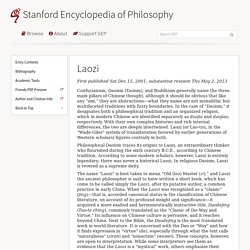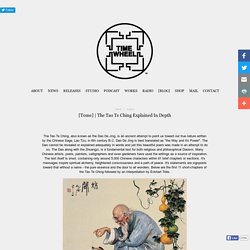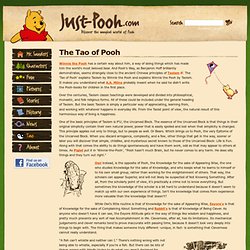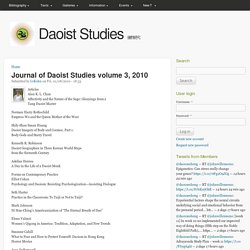

Taoïsme. Taoisme. The Tao. Daoism. Taoism in Bits. Source: Adam Jones.

Creative Commons License. The Simple Tao (Simple Taoism) The Way is to benefit others and not to injure. The Way is to act but not to compete.It does not show greatness and is therefore truly great. Be still like a mountain and flow like a great river Tao"the way", "the path". it is often represented by water because water always seeks the path of least resistance, yet is strong enough to demolish even stone when no other recourse is available. everything below flows from this. The Taoist View of the Universe. At the very roots of Chinese thinking and feeling there lies the principle of polarity, which is not to be confused with the ideas of opposition or conflict.

Tao Te Ching (Dao De Jing) Stories » Ancient Words of Wisdom « Deep Spirits. Taoism 101: Introduction to the Tao. I have been asked many times how to find a Temple, Master or how best to learn Taoism.

Here is a brief Taoism 101 course outline on how to discover Taoism. This is a different type of guide to learning Taoism. Taoism teaches a person to follow their breath, to embrace wonder and the joy in living gracefully with style. Processi Dinamici Globali: la Struttura che Connette dal KaliYuga al Tao. The Dao Bums. IL TAO DEL GUERRIERO. The Path of Water - 21st century Taoism. Taoism and the Arts of China. Asianart.com | Exhibitions Catalogue Asian Art Museum San Francisco February 21 - May 13, 2001 xploring the conceptual and artistic achievements of the Taoist tradition, Taoism and the Arts of China features 150 rare works ranging in date from 500 BCE to 1800 CE, including an extraordinary array of paintings, sculptures, calligraphy, textiles, ritual objects, and scholar's books.

Taoism. Taoism. Daoism / Lao Tzu. Laozi (Stanford Encyclopedia of Philosophy) 1.

The Laozi Story The Shiji (Records of the Historian) by the Han dynasty (206 B.C.E.–220 C.E.) court scribe and historian Sima Qian (ca. 145–86 B.C.E.) offers a “biography” of Laozi. LaoTze - TaoDeJing. Tao Teh Ching - Main Index. The Tao Te Ching Explained In Depth. The Tao Te Ching, also known as the Dao De Jing, is an ancient attempt to point us toward our true nature written by the Chinese Sage, Lao Tzu, in 6th century B.C.

Dao De Jing is best translated as "the Way and it's Power". The Tao Te Ching. The Tao Te Ching (the core Taoist scripture) invites us to open our mind to the underlying mystery and simplicity we lose sight of in daily life.

It doesn’t tell us what to do or think, but rather stimulates us to think and reflect. If you are new to Taoist thought, start with the question, what is Taoist thought? Then, continue on to Understanding the Tao Te Ching. Zhuang Zi - Œuvre de Tchouang-tseu. Welcome to TrueTao.org / Taoism.net. Ressources chinoises - sources primaires - kwoon.org. TaoTao-Project is Free Reaseach Platform for East Asian Studies. Taoism - texts. Winnie the Pooh.
Winnie the Pooh has a certain way about him, a way of doing things which has made him the world's most beloved bear.

And Pooh's Way, as Benjamin Hoff brilliantly demonstrates, seems strangely close to the ancient Chinese principles of Taoism. The 'Tao of Pooh' explains Taoism by Winnie the Pooh and explains Winnie the Pooh by Taoism. It makes you understand what A.A. Milne probably meant when he said he didn't write the Pooh-books for children in the first place.
Taoism in Bits. Tao Te Ching by Lao Tzu - translated and explained by Stefan Stenudd. Preface My first meeting with the Tao Te Ching was in my late teens.

It was Toshikazu Ichimura, my Japanese teacher of the peaceful martial art aikido, who gave me a copy of it – the Gia-Fu Feng and Jane English version with beautiful calligraphy, which is still in print. He thought that my impatiently inquisitive mind would benefit from studying it. Already by reading the first chapter, which compares desire and the freedom from desire without seeming judgmental, I was hooked.
That appeals to a teenager. The book remained with me, far beyond my teen years. Daoist Studies 道教研究. Journal of Daoist Studies volume 3, 2010. Articles Alan K.

L. Three Pines Press - Science and the Dao. Diary of a Daoist Hermit. The Art of Sexual Kung Fu. By Christina Antonyan As a spiritual system, Tao means the way to achieving a true understanding of nature, our mind, and reality, to the way of living in harmony with the changes of nature. Taoism is pronounced as ‘Dow-ism.’ It’s sometimes defined as religion, philosophy, alchemy, a system of magical wisdom, or as a series of health practices similar to yoga. Le Tao de l'Art d'Aimer. Chroniques taoïstes. Tao de la guérison : Mantak Chia.
Taï Chi Chuan Tradition Yang. Taoism. TAO. Wu-Wei / Trying Not to Try: How to Cultivate the Paradoxical Art of Spontaneity. Trying Not to Try - Issue 10: Mergers & Acquisitions. In a famous story from ancient Chinese philosophy, Butcher Ding has been called upon to play his part in a traditional religious ceremony. The ritual, to consecrate a newly cast bronze bell, requires the butcher to sacrifice an ox in a public space, with the ruler and a large crowd looking on. The still-smoking bell is brought fresh from the foundry and cooled with the blood of the sacrificial animal—a procedure that demands precise timing and perfectly smooth execution. Butcher Ding is up to the task, dismembering the massive animal with effortless grace: “At every touch of his hand, every bending of his shoulder, every step of his feet, every thrust of his knee—swish! The Center of Traditional Taoist Studies. The Scholar Sage.
School of Daoist arts. The Tao Te Ching. Taijitu. Centre du symbole du Taiji (Taìjí tú), surnommé en Chinepoissons yin et yang. Le taijitu (chinois simplifié : 太极图 ; chinois traditionnel : 太極圖 ; pinyin : taìjítú ; Wade : t'ai⁴chi²t'u²) (figure du faîte suprême), encore appelé « symbole du Yin et du Yang » ou « symbole taoïste », est un symbole chinois associé au taoïsme et au néo-confucianisme. Ce sont les penseurs de ce dernier courant, en particulier Zhu Xi, qui l’ont popularisé à partir des Song sous la forme ci-contre, la plus généralement connue, parfois entourée des huit trigrammes (bāguà) (1).
D’autres formes existent, dont celle décrite par Zhou Dunyi et utilisée pour la pratique de l’alchimie interne taoïste neidan. Il figure sur le drapeau de la Corée du Sud, avec les couleurs rouge et bleue, autre représentation courante de ce symbole. Omoté-Ura, Yin-Yang - AikiAutrement. Contrairement à ce que l’on pourrait penser, les notions de omoté et ura , ne sont pas réservées aux techniques d’aïkido ou à son vocabulaire. La philosophie et les sciences antiques, nous placent en face d’une pelote de laquelle il n’est pas aisé de tirer les fils pour en démêler le sens : les différents constituants, pris isolement sont très simples, la complexité réside en un ensemble d’interaction et d’interdépendance.
Omoté et Ura sont intimement liés à la théorie du Yin /Yang qui découle de celle du Ki (Qi) et du Do (Tao). Dans la société japonaise. Omoté et Ura qui désignent respectivement l’endroit - le recto - et l’envers- le verso- ce sont des termes qui caractérisent la double structure de la mentalité japonaise : la façade (Tatamaé) – principe de convenance sociale - et la vérité individuelle (Honné). Le côté « envers », ura, est le plus important, il a un caractère formel et codifié, c’est ce que l’on ne dit pas officiellement mais c’est ce qu’il faut comprendre. 15 Profound Quotes From Lao Tzu That Will Open Your Mind Wide Open - Hack Spirit. Have you ever heard of Lao Tzu? If not, then my word you’re in some wisdom today. Lao Tzu was the founder Taoism, the highly influential philosophy that emphasizes humility, mindful living and fulfilment in life.
He is known to have masterfully implemented detachment, letting go and simplicity in his life. The Jade Turtle Records 碧龜記. The Three Pure Ones – Three Stars. San qing. Statue de Daode tianzun, temple Changchun, Wuhan. Il Taoismo e il Taoismo Alchemico nella filosofia cinese. La scienza in Cina: dai Qin-Han ai Tang. Immortalità del corpo umano: l'alchimia in "Storia della Scienza" Wudang, le montagne sacre al taoismo. Confucianism. Confucianism - Understanding Religion in Late-Imperial China.